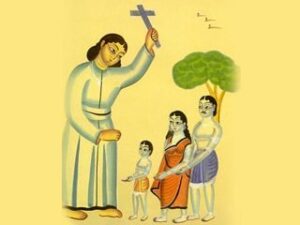
As news spreads that adornment of “Sainthood” to “Blessed Devasahayam” by Vatican in May 2022, it is imperative to visit the historical facts to know who this “Blessed Devasahayam” is and why Vatican is keen to canonise him. As Roman Catholic Church keeps peddling its version (see appendix), a fair analysis of historical facts and sequence throws up a completely different version on the alleged “life” and “martyrdom” of Devasahayam Pillai.
** Former Chairperson of Indian Council for Historical Research (ICHR) Shri MGS Narayanan questions the very existence of an entity called “Devasahayam Pillai”. He says he had never come across any one named either Neelakantan Pillai (purported Hindu name of the man in question) or Devasahayam Pillai as the army commander of Marthanda Varma in Kerala’ s history.
** Nagam Aiyya, who recorded the history of Travancore princely state observes, “It is one evidently started by the later converts, from a habit of apotheosizing their ancestors or heroes; so common among the people (Travancore Manual, Vol II, Page 129-130, V. Nagam Aiya).
The second touch point in the Devasahayam Pillai’s story is that he was punished for his conversion and spreading the message of peace and love. A cursory reading of the history of Travancore Maharajas would amply demonstrate their broadmindedness and their inclusive approach. Renowned historian Sreedhara Menon in an interview to The Pioneer dated January 20, 2004 asserts, “Leave alone execution, not even a single case of persecution was recorded in the history of Travancore in the name of religious conversion. It is a well-concocted story and a figment of the imagination.”
There are recorded evidences of many Christians and Muslims serving in his army and government during the tenure of Maharajas, particularly Maharaja Marthanda Varma. As this is the historical fact, trying to taint a person of virtue like Maharaja Marthanda Varma with religious bigotry allegation is to be condemned. During the times of Maharaja Marthanda Varma, the army of Travancore had Izhavas, Christians and Muslims, records T.K. Velupillai in his Travancore Manual, Vol IV, Page 122, quoting Colonel Wilks.
The very Maharaja of Travancore, who is said to have persecuted Devasahayam Pillai on account of Pillai converting to the Christian religion and for converting others to Christianity, has in fact extended tax exemption for the lands that he gifted to the Church at Varappuzha. (Travancore Manual, Vol. I, Page 16, T.K. Veluppillai).
Pope Clement XIV in his letter dated 2nd July 1774, expresses his thanks to Maharaja for “his kindness towards the members of his Church resident in Travancore” (Travancore Manual, Vol I, Page 387, M. Nagam Aiya).
It is also pertinent to note that in the alleged times of Devasahayam Pillai, there were bloody clashes between Roman Catholics and Protestants in Europe and other parts of the world. The Dutch De Lannoy was a protestant, Christian. They were vested with the right to authorise baptism of newly converted by Protestant church. Given this, why would De Lannoy send Devasahayam Pillai to his rival Roman Catholic Church for baptism?
It is recorded by T.K. Velu Pillai in his Travancore Manual, Vol IV, Page 77, that capital punishment is awarded to crimes for (1) inciting or committing acts of insurrection and pre-meditating or attempting the death of the Maharaja, (2) murder (3) gang robbery.
Based on these observations, the history of Travancore as recorded by Nagam Aiya can be viewed.“Probably as a palace official, Devasahayam Pillai was detected tampering with political secrets, on the strength of which action must have been taken against him, years after he was converted to Christianity. Baptism could not have had anything to do with it” (Travancore Manual, Vol II, Page 130, M. Nagam Aiya).
Why Roman Catholic church goes to town tomtoming the glory of a person allegedly from South India now? The cat is out of the bag. See what Prof. C I Issac, retired professor of History admits to: “The birth of newer saints will boost the morale of the nuns and clergy. In an age that criticises the Church’s educational business and proselytism, miracles by native saints can attract more Hindus. Under the fascination of miracles of saints, if Hindus are converted to Christianity, no one can blame it as a proselytising enterprise. That is the logic behind the elevation of people to sainthood in strategic regions”.
Hence, it is very evident that the bogey of sainthood to fictitious Devasahayam Pillai by Vatican is yet another attempt by Church to unleash fresh lease of conversions and “harvest souls”. Vatican has the habit of disregarding the saints canonised in the past and enact fresh fables to create new “saints”, who are contemporary and would come handy to their conversion ploy. In that process, Vatican not only insults Hindu society and Hindu rulers of the past, but also paves way for communal clash and disharmony in contemporary society by spreading the story of Devasahayam Pillai and his alleged martyrdom. This is unacceptable
The Dalai Lama, while attending a Christian function at Cochin, attested to the age-old Indian tradition of equal respect for all religions as “India exemplified how different religious faiths and traditions could live in harmony and she is the noble paradigm of spiritual harmony and coexistence” (Matrubhoomi Daily, The Hindu, Deccan Chronicle, Cochin November 26, 2012).
This traditional characteristic of Kerala society was acknowledged by an eminent historian: “The Hindu rulers of ancient Kerala followed a policy of enlightened religious toleration. The progress of the faith was, in many respects, due to the tolerant policy pursued by the rulers of Kerala.” (A Sreedhara Menon, A Survey of Kerala History, 1970, pp 92, 104).
Above all, Maharaja Marthanda Varma’s broadmindedness to accept De Lannoy, a Flemish Christian, as commander-in-chief of his forces is sufficient and self-explaining testimony to the Hindu social psyche of the day. In short, Kerala’s track record in the history of harmonious coexistence of religions is exemplary since the dawn of its civilization to the present.
With the above facts staring in front, it is hard to believe the “existence” of Devasahayam Pillai and his “martyrdom”. It appears to be more of a myth, fiction and unhistoric, spread by Roman Catholic church solely to augment their conversion drive. Canonisation of Devasahayam Pillai could pave way for communal disharmony and denigration of native culture and civilization. It would be in the interest of larger communal harmony if Devasahayam Pillai’s canonization is put on hold forever.
APPENDIX
THE CONTROVERTIAL CHURCH VERSION
Neelakandan Pillai (Devasahayam Pillai’s original Hindu name) was born in 1712 CE in Travancore kingdom. Born in a Nair family, Neelakandan Pillai was initiated into Hindu way of life by his father who was a priest in a Perumal temple. With his clout with the king Maharaja Marthanda Varma, he got a job for his son Neelakandan Pillai in the Palace. With his hard work and dedication, Neelakandan Pillai grew in ranks and was put in charge of state affairs under the Dewan of Travancore Ramayyan Dalwa. Subsequently, Neelakandan Pillai was elevated to command a part of Maharaja’s army.
As things went like this, in the year 1741 CE, Dutch naval commander De Lannoy invaded Travancore. He got defeated, captured and imprisoned in the Battle of Colachel. However, Maharaja Marthanda Varma pardoned De Lennoy and his men and ordered them to be loyal to his kingdom. De Lannoy was made General of Maharaja’s army. He displayed his loyalty to the Maharaja and won many battles for his kingdom. During this period, he came in contact with Neelanandan Pillai and got closer to him.
De Lannoy enlightened Neelakandan Pillai about Christian faith, leading to his conversion in 1745 CE. De Lannoy sent Neelakandan Pillai to the Roman Catholic Latin Rite Church at Vadakkankulam village (in the present-day Tirunelveli District of TN) for baptism. Upon baptism, he changed his name to “Lazarus” (meaning God’s Help in Latin), but widely known by his local name “Devasahayam” (with the same meaning in Tamil and Malayalam).
After his conversion to Christianity, Devasahayam Pillai started socialising with people of all communities alike and in fact facilitated conversion of many Hindus to Christian fold, thereby relieving them from the caste atrocities.
This has irked Brahmins as well as his community members in general and Ramayya Dalwa in particular. They were waiting for a chance to pull down Devasahayam Pillai. Around 1749 CE, they levelled false charge of divulging state secrets to Europeans against Devasahayam Pillai and arrested him. Though the reason as announced to the public is espionage and treason, the actual reason for his arrest is his conversion to Christianity and spreading the message of peace and love amongst the members of his kingdom. He was tortured in custody for 3 years and ordered to be executed. As a torture routine, he was tied to a neem tree for days together without food and water. After he was moved to another location, the leaves of the neem tree cured diseases of many people and this enhanced his image in the eyes of public. They started revering him. Devasahayam Pillai was ordered to be paraded on a buffalo to Kuzhumaikkad where he was supposed to be executed. However, as he reached Kuzhumaikkad, Maharaja had a change of heart in the last minute and ordered him to be exiled to Aralvaimozhi (Pandya kingdom). Upon reaching Aralvaimozhi, Devasahayam Pillai continued his “divine” service and finally on 14th January 1752, he was shot by Maharaja’s men or British forces. On hearing his death, his followers went to Aralvaimozhi and brought back his dead body to be buried in St.Xavier’s Church, Kottar, Nagercoil.
Devasahayam Pillai was declared a “martyr” on 28th June 2012 (on his 300th birth anniversary year) by the then Pope Benedict XVI and was beatified on 2nd December 2012. He will be canonised (sainthood) on 15th May 2022 in Vatican by Pope. His Sainthood is glorified as the “first lay Indian to become a saint” and “son of the soil becomes a saint”.

